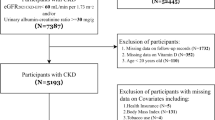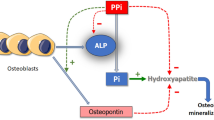Abstract
IGF-I is an anabolic hormone which has been reported to increase bone formation in several conditions of undernutrition. Advanced liver cirrhosis is associated with osteopenia and also with low serum levels of IGF-I. Previous results showed that low doses of IGF-I increase osteoblastic activity and decrease bone reabsoption in early liver cirrhosis. The aim of this study was to evaluate whether IGF-I-treatment also induces beneficial effect on osteopenia associated with advanced cirrhosis. Rats with ascitic cirrhosis were divided into two groups: group CI (n=10) which received saline and group CI+IGF (n=10) which were treated with IGF-I (2 μg/100 g bw. day, sc, during 21 days). Healthy controls which received saline were studied in parallel (CO n=10). On the 22nd day, the animals were sacrificed, and bone parameters were analyzed in femur. Posterior-anterior diameter was similar in all groups. No significant differences were observed in bone content of calcium, total proteins, collagen and hydroxyapatite in cirrhotic rats as compared with controls. However, CI rats showed significant reductions in total bone density (−13.5%, p<0.001) assessed by densitometry) and radiological study. In CI+IGF rat bone density (assesed by densitometry) improved significantly as compared with CI animals. In summary, osteopenia characterized by loss of bone mass and preserved bone composition was found in rats with advanced cirrhosis induced by CCl4 and phenobarbital in drinking water. This bone disorder is partially restored by treatment with low doses of IGF-I during only three weeks. Thus, IGF-I could be considered as a possible therapy for osteopenia associated with advanced liver cirrhosis.
Resumen
IGF-I es una hormona anabólica con efecto sobre el metabolismo óseo. La cirrosis hepática avanzada está asociada con osteopenia y también con bajas concentraciones de IGF-I en suero. Resultados anteriores de nuestro grupo muestran que dosis bajas de IGF-I aumentan la actividad osteoblástica y reducen la resorción ósea en estadíos compensados de cirrosis hepática. El objetivo de este estudio consiste en evaluar si el tratamiento con IGF-I induce también un efecto beneficioso en la osteopenia asociada a cirrosis avanzada. Ratas con cirrosis ascítica se dividen en dos grupos: grupo CI (n=10), que reciben salino, y grupo CI+IGF (n=10) tratadas con IGF-I (2mg/100 g peso corporal/día, sc, durante 21 días). Controles sanos, que reciben salino, se estudian al mismo tiempo (CO n=10). El día 22, los animales se sacrifican y se analizan parámetros óseos en fémur. El diámetro antero-posterior es similar en todos los grupos. No se observan tampoco diferencias significativas en el contenido óseo (calcio, proteínas totales, colágeno, hidroxiapatita) en las ratas cirróticas al compararlas con los controles. Sin embargo, en los animales cirróticos se observa una reducción significativa de la densidad total ósea (−13.5%, p<0.001) medida por densitometría, reducción que se aprecia también en el estudio radiológico. En las ratas CI+IGF la densidad ósea mejora significativamente en comparación con los animales cirróticos sin tratamiento. En resumen, se observa osteopenia caracterizada por pérdida de masa ósea, en la que se preserva la normal composición del hueso, en ratas con cirrosis avanzada inducida por CCl4 y fenobarbital en el agua de bebida. Esta disminución de la masa ósea se recupera parcialmente por el tratamiento con dosis bajas de IGF-I durante sólo tres semanas. Por lo tanto, IGF-I podre ser considerado como una posible terapia para la osteopenia asociada a la cirrosis hepática en estadíos avanzados.
Similar content being viewed by others
References
Bagi, C. M., Brommage, R., Deleon, L., Adams, S., Rosen, D. and Sommer, A. (1994):J. Bone Miner. Res.,9, 1301–1312.
Bautista, C. M., Mohan, S. and Baylink, D. J. (1990):Metabolism,39, 96–100.
Bonkovsky, H. L., Hawkins, M., Steinberg, K.,et al. (1990):Hepatology,12, 273–280.
Canalis, E. (1996): In: “Primer of Metabolic Bone Disorders of Mineral Metabolism, 3rd ed.” (Favus, J. F. ed). Lippincott-Raven Publishers, Philadelphia. pp. 29–34.
Castilla-Cortázar, I., García, M., Muguerza, B., Pérez, R., Quiroga, J.,et al. (1997):Gastroenterology,113, 1682–1691.
Castilla-Cortázar, I., Prieto, J., Urdaneta, E., Pascual, M., Nuñez, M., Zudaire, E.,et al. (1997):Gastroenterology,113, 1180–1187.
Castilla-Cortázar, I., García, M. Quiroga, J. Calvo, A., Díez, N.,et al. (2000):Hepatology,31, 901–910.
Castilla-Cortázar, I., Núñez, M., Urdaneta, E., Pascual, M., Muguerza, B., Quiroga, J.,et al. (1996):J. Hepatology,S1, 64.
Cemborain, A., Castilla-Cortázar, I., García, M., Quiroga, J., Muguerza, B., Picardi, A.,et al. (1998):J. Hepatology,28, 122–131.
Compston, J. E. (1986):Gut.,27, 1073–1075.
Diamont, T., Stiel, D., Lunzer, M., Wilkinson, M., Roche, J. and Posen, S. (1990):Gut.,31, 82–87.
Ebeling, P. R., Jones, J. D., O’Fallon, W. M., Janes, C. H. and Riggs, B. L. (1993):J. Clin. Endocrinol. Metab.,77, 1384–1387.
Fiorelli, G., Orlando, C., Benvenuti, S.et al. (1994):J. Bone Miner. Res.,9, 329–337.
Grinspoon, A. K., Baum, H. B. A., Peterson, A. and Klibanski, A. (1995):J. Clin. Invest.,96, 900–906.
Guichot-García, M. R., Lluch-Fernández, M. D. and Ramos-Sánchez, I. (1992):An. Esp. Pediatr.,37, 109–113.
Hattori, N., Kurahachi, H., Ikekubo, K., Ishihara, T., Moridera, K., Hino, M.,et al. (1992):Metab. Clin. Exp.,41, 377–381.
Hay, J. E. (1995):Gastroenterology,108, 276–283.
Hodgson, S. F., Dickson, E. R., Wahner, H. W., Johnson, K. A., Mann, K. G. and Riggs, B. L. (1985):Ann. Intern. Med.,103, 855–860.
Johansson, A. G., Lindh, E. and Ljunghall, S. (1992):Lancet,339, 1619–1626.
Jones, J. I. and Clemmons, D. R. (1995):Endocr. Rev.,16, 3–34.
Lewis, D. F. V. (1996): “Cytochromes P-450: Structure, Function and Mechanism”. Tailor & Francis Ldt., Bristol.
Mezey, E. (1978):Gastroenterology,74, 770–783.
Mohan, S. and Baylink, D.J. (1990):Growth Genet. Horm.,6, 1–9.
Muguerza, B., Lecaroz, C., Picardi, A., Castilla-Cortázar, I., Quiroga, J., Cemborain, A., Prieto, J. and Santidrian, S. (1996):J. Physiol. Biochem.,52, 113–120.
Müller, M. J., Lautz, H. U., Plogmann, B., Bürger, M., Körber, J. and Schmidt, F. W. (1992):Hepatology,15, 782–794.
Pascual, M., Castilla-Cortázar, I., Urdaneta, E., Picardi, A., Quiroga, J. and Prieto (2000):Am. J. Physiol., in press.
Picardi, A., Costa de Oliveira, A., Muguerza, B., Tosar, A., Quiroga, J., Castilla-Cortázar, I.,et al. (1996):J. Hepatol.,24, 267–279.
Pimstone, N. R., Goldstein, L. I., Ward, R. and Ruebner, B. H. (1990): In: “Hepatology: a Textbook of Liver Disease Volume 2. 2nd ed.” (Zakim and Boyer eds). W.B. Saunders Company, Philadelphia. pp. 791–821.
Robyt, J. F. and White, B. J. (1987): “Biochemical techniques, theory and practice”. Brooks and Cole Publishing Company, New York.
Schimpf, R. M., Lebrec, D. and Donadieu, M. (1977):Acta Endocrinol.,86, 355–362.
Stellon, A. J., Webb, A., Compston, J.,et al. (1987):Hepatology,7, 137–142.
Teodore, T. H. (1993): In: “Primer on the Metabolic Bone Diseases and Disorders on Mineral Metabolism, 2nd ed.” (Murray, J.F. ed). Raven Press, New York. pp. 250–254.
Willis, J. B. (1960):Spectrochim. Acta,16, 259–264.
Woessner, J. F. (1961):Arch. Biochem. Biophys.,93, 440–447.
Wuzke, A. (1985):Z. Med. Laboratoriums Diagn.,26, 383–387.
Author information
Authors and Affiliations
Corresponding author
Rights and permissions
About this article
Cite this article
Cemborain, A., Castilla-Cortázar, I., García, M. et al. Effects of IGF-I treatment on osteopenia in rats with advanced liver cirrhosis. J. Physiol. Biochem. 56, 91–99 (2000). https://doi.org/10.1007/BF03179904
Received:
Issue Date:
DOI: https://doi.org/10.1007/BF03179904




